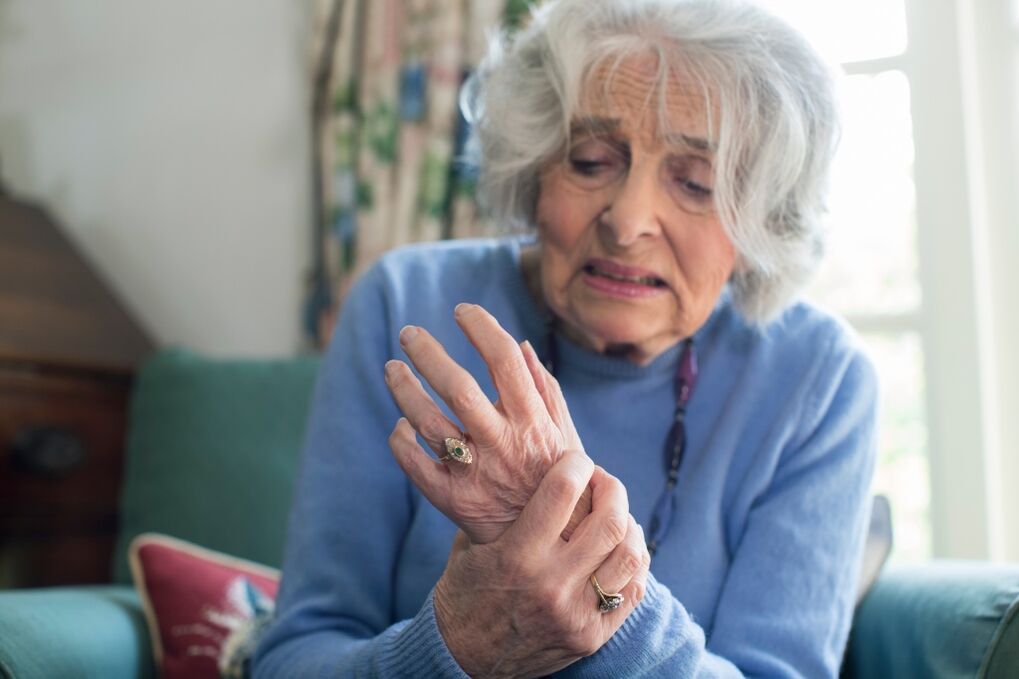
Arthrosis of the joints (the names "deforming arthrosis", "osteoarthritis" or "osteoarthritis" can also be found in the literature) is a chronic degenerative process of the joint tissues, in which, due to dystrophic processes, with theTime, the cartilage that covers the joint surfaces is destroyed, in addition, degenerative processes can cover the joint capsule and the bone tissue itself, causing bone deformations.
Types of osteoarthritis of the joints.
In general, the term "arthrosis" is used to refer to a fairly large group of diseases of different joints, the mechanism of development of such pathologies may differ to some extent. Very often, you can find osteoarthritis of large joints, this group of diseases includes:
- gonarthrosis - a deforming injury of the knee joint;
- coxarthrosis - a pathology of the hip joint;
- osteoarthritis of the shoulder joint;
- osteoarthritis of the elbow joint, etc.
Less frequently, osteoarthritis of small joints develops: hands (most often interphalangeal and metacarpophalangeal) and feet. In addition, spondyloarthrosis is distinguished, a dystrophic lesion of the intervertebral joints, which is known as diseases of the spine, despite the mechanism of development similar to other types of osteoarthritis. In the event that the pathology has spread to several joints, we can say about generalized osteoarthritis or polyarthrosis.
In medicine, it is customary to distinguish two main types of arthrosis of the joints, depending on the mechanism of their development. Primary osteoarthritis (also called idiopathic) is a pathology that develops mainly in the tissues of the joint, outside of any deviation in the systemic work of the body. Primary osteoarthritis is characterized by an increase in degenerative processes in cartilage tissue simultaneously with a violation of its restoration.
Secondary osteoarthritis is the result of injury to the joint due to trauma (traumatic osteoarthritis). In addition, certain pathological processes in the body, in particular, mineral metabolism disorders and others, can lead to the development of secondary osteoarthritis.
At an early age, as a rule, traumatic osteoarthritis is detected. In elderly patients, in some cases, it is not possible to distinguish between primary and secondary joint damage, so closely related are many pathological processes in the body.

Why does osteoarthritis develop?
Despite the fact that there is still no consensus on the exact cause of the development of osteoarthritis, scientists know the factors that contribute to pathological changes in the tissues of the joint. The main reason for the development of idiopathic arthrosis of the joints is a variety of factors of a hereditary and genetic nature. First of all, this group includes congenital characteristics of the composition of the tissues of the joint, which contribute to a more intense than normal destruction of cartilage and its too slow recovery. In addition, hereditary factors can include a variety of congenital defects and deformities of the osteoarticular system (dysplasia of the joints, their excessive mobility, deformities of the spine, feet, hands, etc. ), for which an excessive or non-physiological is placedload on certain joints. , why the articular surfaces can develop incorrectly, deform, and the cartilage that covers them - collapse;
The following reasons can lead to the development of secondary osteoarthritis of the joints:
- Mechanical damage to the joints is the result of certain mechanical influences that lead to a violation of the anatomical integrity of the structures that make up the joint. The group of mechanical injuries includes injuries, surgical interventions, excessive physical activity and sports;
- joint diseases: first of all, pathologies of an inflammatory nature;
- metabolic disorders that lead to changes in the composition of the cartilage that covers the joint surfaces, due to which it becomes more vulnerable, breaks down faster and recovers more slowly;
- some diseases of the endocrine glands, which can also lead to metabolic disorders;
- a series of autoimmune pathologies in which the cells of the immune system attack the body's own tissues, in this case, the tissues of the joints, causing destruction;
- vascular pathologies, the result of which is insufficient blood supply to tissues and the development of dystrophic processes in them.
How does osteoarthritis of the joints develop?
The first destructive process in the joint in osteoarthritis of the joints is believed to be the defeat of the cartilage. It begins with a violation of microcirculation in the capillaries of the periosteum, located under the cartilage that covers the articular surface of the bone. Normally, the nutrients in cartilage tissue come from both joint fluid and adjacent bone tissue. When the blood circulation in the periosteal vessels is disturbed, the nutrition of the cartilage is disturbed. Gradually, the cartilage tissue loses its natural elasticity, becomes thinner, its surface becomes uneven, microcracks and tubercles may appear on it, disrupting the gliding of the articular surfaces relative to each other. The composition of the synovial fluid inevitably changes.
With movements in the joint, pain, creaking, clicks begin to bother. Over time, the pathology progresses, the range of motion in the joint decreases, the joint space becomes narrower, the cartilage in the protruding parts of the joint surfaces can thin out completely, and osteophytes form on the edges of the joints. articular surfaces. .
The described mechanism is mainly characteristic of senile osteoarthritis, which develops gradually over time. The mechanism of development of other forms of osteoarthritis, for example, post-traumatic, postoperative, post-infectious, associated with metabolic disorders, may be slightly different, but in general, changes in the joint with such pathologies will be identical to senile osteoarthritis. .
The degree of osteoarthritis and its manifestations.
Specific manifestations of the pathological process, its severity largely depend on the intensity of the destructive process in the joint, the amount of tissue involved in it. However, there are two main clinical symptoms characteristic of osteoarthritis at any stage. First of all, it is a joint pain. Also, decreased joint mobility is cause for concern.
In our country it is customary to distinguish the degrees of osteoarthritis according to the clinical and radiological classification adopted in 1961.
Arthrosis of the joints 1 degree- the initial stage of the development of the pathological process.Its main symptom is stiff joint movements in the morning, after rest. Once the patient begins to move, the stiffness goes away. In the joints, there may be some alteration of mobility, slight pain can bother after being at rest, during the first movements. Cracks in the joints are often noted. However, there is no pronounced pain after performing normal movements, the pain may appear only with a clearly excessive load on the joint, and after rest it disappears on its own.
X-ray examination of the affected joint does not show pronounced changes in anatomical structures; In some cases, there may be a slight narrowing of the joint space or the presence of single, small bony growths along the edges of the joint surface.
Due to the absence of obvious pain and movement disorders in the joint, patients rarely seek medical help at this stage in the development of the disease.
2 degree of osteoarthritis - the progression of the disease.It is manifested by the appearance of severe acute pain, as well as a distinctive crunch, clicking in the joint during movements in it. The range of motion in the joint is significantly limited, so if we talk about the defeat of a large joint, the development of functional shortening of the limb is possible. The pains bother in the morning, immediately after waking up, as in the first stage of osteoarthritis, but unlike it, they are more intense, longer, often gradually turning into daytime pains. The latter are formed during the day, when mechanical work on the joint gradually decreases the cartilage's ability to pay off. At this stage, there is a fairly significant destruction of the joint, deformations of the bones that form it. The meteosensitivity of the joint can be disturbing: the appearance or significant intensification of pain in it when the weather changes, which is associated with a decrease in the compensatory properties of the joint tissues and their ability to regulate intra-articular pressure during atmospheric fluctuations. Pressure.
X-ray examination shows a significant narrowing of the joint gap, a significant number of bone growths. The bone tissue in the pericartilaginous area is sclerosed due to pronounced dystrophic processes; cystic cavities may form in it.
At this stage of the disease, the patient's work capacity decreases; He is unable to perform a series of jobs due to severe pain during movements of the affected joint or its contracture.
Arthrosis of the joints of the third degree corresponds to the advanced stage of the pathological process.Pain is constantly disturbing, both during movement and in a state of complete rest, which is associated with a number of factors: inflammation of joint tissues, deformation of joint surfaces, muscle spasm around them. The range of movements is very limited, in some cases they are generally impossible. Movement in the affected joint is accompanied by a loud crack, audible not only to the patient, but also to those around him. The joint at this stage is significantly deformed, fluid accumulates in the joint capsule due to the intense inflammatory process. Severe meteosensitivity develops - intensification of pain due to climatic changes. Muscles in the area of large joints are spasmodic, due to lack of mobility, their atrophy may develop. With arthrosis of the third degree of the knee joints, the curvature of the legs can be noted: varus (in the form of the letter "O") or valgus (in the form of the letter "X").
X-ray images reveal an almost complete absence of the joint space, the joint surfaces are significantly deformed, and large bony growths are found on their edges. The intra-articular structures (menisci, ligaments) are destroyed, the bone tissue is sclerosed. The tissues around the joint are calcified, articular mice can appear in the joint cavity - fragments of bone tissue.
With arthrosis of the joints of the third degree, there is a persistent decrease in the patient's ability to work, his disability.
4 degree of arthrosis - the stage of complete destruction of the affected joint.His "blockage" develops: the impossibility of even the slightest movements due to severe pain. Pain cannot be relieved even with strong non-narcotic pain relievers, they are not relieved by physical therapy procedures. With the defeat of the knee joints, the patient loses the ability to move independently. Severe inflammation in the joint tissues can lead to fusion of the joint (ankylosis) or the formation of false joints (neoarthrosis).
The radiograph shows the stronger sclerosis of the bones that make up the joint, their fusion, a large number of osteophytes and an intense calcification of the joint tissues.
How is osteoarthritis treated?
The scope of therapeutic measures for the treatment of arthrosis of the joints depends on the stage of the disease and the prevalence of the pathological process. There is a simple pattern: the earlier treatment for osteoarthritis is started, the more effective it will be. Therefore, it is very important to consult a doctor in a timely manner, at the first signs of discomfort in the joint area, at the slightest morning stiffness or the appearance of a crunch during movements. At the initial stages of the pathological process, it is effective to take vitamin-mineral complexes and chondroprotectors - drugs that improve metabolism in cartilage tissue and its structure. For example, a drug whose active ingredient is crystalline glucosamine sulfate, a natural component of healthy cartilage. It stimulates the production of proteoglycans and at the same time inhibits the processes of destruction of cartilage tissue.

A good addition to the listed measures to treat osteoarthritis will be physical therapy exercises, physical therapy techniques, it is important to have a good diet with a sufficient amount of protein and fat in the diet. Timely therapeutic and prophylactic measures make it possible not only to eliminate pain and discomfort, but also to prevent the progression of the disease, the transition of pathology to more serious stages.
Osteoarthritis of the second and most serious degree cannot be completely cured. In these stages, the treatment of osteoarthritis is reduced to the elimination or reduction of pain, as well as the suppression of inflammation in the tissues of the joint. To relieve pain, non-steroidal anti-inflammatory drugs and non-narcotic analgesics are used, in the form of local agents (ointments, gels with anesthetic and anti-inflammatory effect), as well as systemic drugs. An important role is played by relieving the load on the diseased joint, thereby reducing mechanical damage to the joint surfaces.
After the acute pain is eliminated, an important task is to normalize the metabolic processes in the cartilage tissue, slow down the destructive processes in it, for which it is also recommended to take chondroprotective drugs. In addition, drugs that stimulate tissue microcirculation have proven effective. In the remission stage of osteoarthritis (in the absence of severe pain), physical therapy exercises and physical therapy are helpful, which will reduce the likelihood of another exacerbation and reduce the need for painkillers and NSAIDs.
The list of physiotherapeutic measures in the treatment of osteoarthritis of the joints includes electrophoresis, exposure to ultrasound, radiation and magnetic therapy. The most important condition for the effectiveness of such measures is the performance of physiotherapeutic treatment of arthrosis only during the period outside the exacerbation of the disease; otherwise, there is a high probability of activating the inflammatory process and increasing pain.
How to treat osteoarthritis in the fourth stage of the disease? The tissues of the joint at this stage are practically destroyed, the only effective solution is surgical intervention, during which the damaged joint is replaced with a special endoprosthesis. Not always, such an operation allows you to fully restore the range of motion in the joint, however, after the completion of the recovery period, the patient can return to active life, work and get rid of pain.
Osteoarthritis, the symptoms and treatment of which are described in this article, is a serious pathology that can lead to disability, significantly reducing the quality of your life. Timely treatment can significantly slow down the progression of the disease, prevent the development of serious complications, and maintain the activity and work capacity of the patient.



















